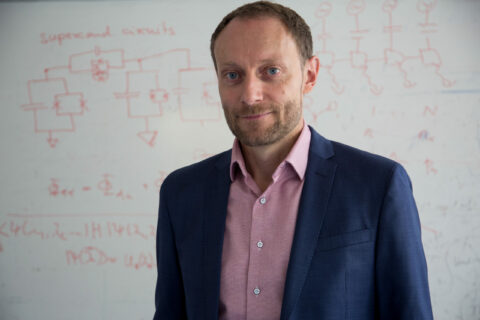Quantum computers: When quantum hardware meets artificial neural networks

“We are at the 10th kilometer in the marathon”
Quantum computers could double the computing power of today’s supercomputers. But how far away are they from becoming reality? What can we expect in the coming years? We spoke with Prof. Dr. Michael J. Hartmann, Chair of Theoretical Physics. Among other things, he is researching ways to connect artificial neural networks with quantum hardware.
Prof. Hartmann, you are investigating ways to connect quantum hardware with machine learning. Does that mean working quantum computers have been developed already?
If you’re thinking of a compact device like a PC or laptop, then the answer is clearly no. But there are experimental setups that combine multiple qubits and which are already being used to perform computations. Multiple combined qubits are similar to the processors of classical binary computers, but they work with quantum states rather than ones and zeros. One the one hand, quantum computers are far superior, because the computing power theoretically doubles with each additional qubit. On the other hand, they are extremely sensitive to sources of interference and must be shielded accordingly.
What implications does this have?
Qubits consist of coils, capacitors and so-called Josephson contacts – these are two wire tips that touch each other via a wafer-thin oxide layer. For the currents in these components to flow absolutely smoothly, they must be cooled to about ten millikelvin. This is close to absolute zero. But even that is not enough. We need to make sure that only qubits that are intended for the respective gate operation communicate with each other. And we need to find reliable ways to enter commands and get results without destroying the quantum information.
And that’s what you’re researching in Erlangen?
Yes it is. My colleagues, in particular Professor Christopher Eichler, and I are mainly working on two research goals here: Firstly, we are attempting to design and improve the qubits themselves and the surrounding hardware. These are partly entirely practical aspects, such as housing for quantum chips and wiring. For the control system, we are developing microwave circuits that are as close as possible to the chips and enable pulses in the nanosecond range. The second level is theoretical: this involves, for example, designing circuit concepts to decouple qubits that are not supposed to interact with each other. Interference effects, for example, can be used for this purpose. In my working group particularly, we are simulating such concepts and incorporate various interference effects to make quantum processors more robust for practical use.
Let’s get back to quantum hardware and artificial neural networks. What research are you working on here?
We are doing similar work to machine learning using classic computers. A prominent example of the use of artificial neural networks is image recognition. There, the program is trained with pictures – let’s say of cats and dogs – and learns characteristics of the animal species, in order to then be able to classify them independently. But rather than training our processors with images of cats and dogs, we use quantum mechanical wave functions. The algorithm was able to detect correlations between electron spins and distinguish different types of magnetism. Applying the underlying quantum algorithm to a 100-qubit processor involves so many computational operations that a classical computer would not be able to perform.
Would this be a typical field of application for quantum computing?
Yes, certainly. Quantum mechanical processes in particular are so complex that they can only be calculated with a quantum computer. But there are also other areas of application, such as the simulation of chemical reactions – with the aim of making processes safer or more energy-efficient. The combination possibilities at the molecular level are so numerous that they exceed the computing power of conventional technologies.
When do you think that we will see the first quantum computers in data centers?
I like to compare the development of the quantum computer with a marathon run and would say we are at the tenth kilometer. Over three years ago, Google performed a 53-qubit gate operation and demonstrated quantum superiority for the first time. Nevertheless, we are still working on the basics of this technology. This is mainly due to the fact that quantum computers are much more prone to errors than classic computers.
What can we do to make quantum computers more reliable?
There are currently two strategies for this: One is to make a gigantic quantum computer with up to one million qubits. This creates capacities for redundant operations and can eliminate errors according to probability algorithms. We are pursuing a different strategy and want to develop qubits that present quantum states for much longer than just a few microseconds, as has been the case so far. This makes them more robust, and you need fewer qubits for a reliable correction. We are looking forward to seeing which concept will prevail.
Quromorphic Winter Workshop
The Quromorphic Winter Workshop will took place in Erlangen from February 14 to 16, 2023. At the congress, the results of the EU-funded project Neuromorphic Quantum Computing (Quromorphic) were presented, which explores the possibilities of connecting artificial neural networks with quantum hardware.
Further information
Prof. Michael J. Hartmann
Chair of Theoretical Physics
Phone: +49 9131 85 28461
michael.j.hartmann@fau.de